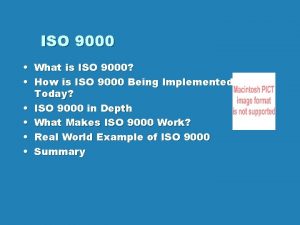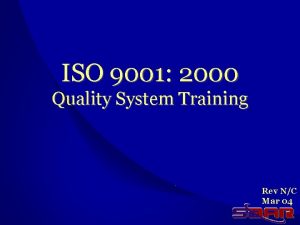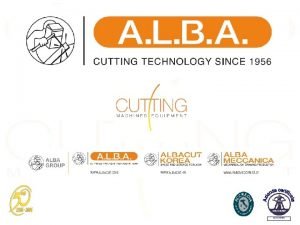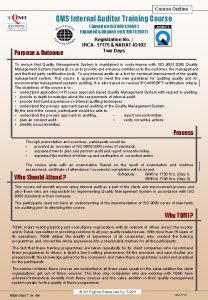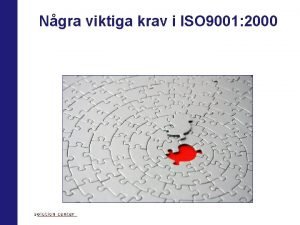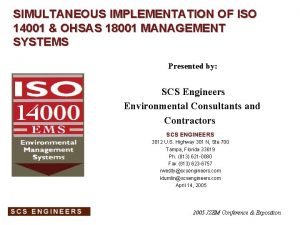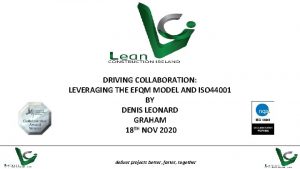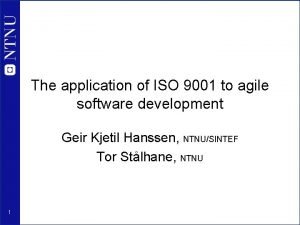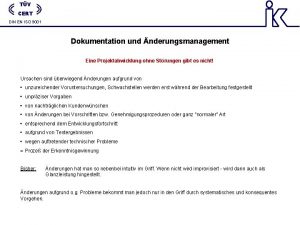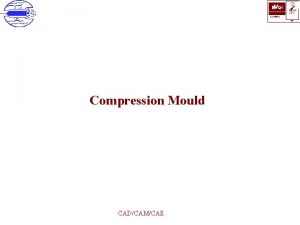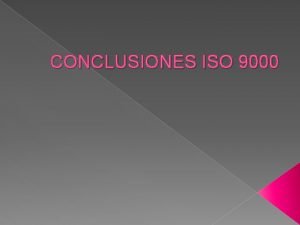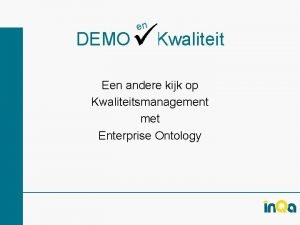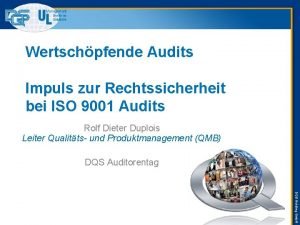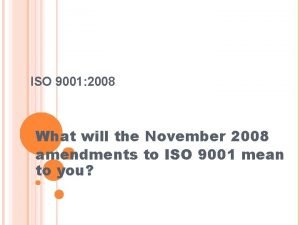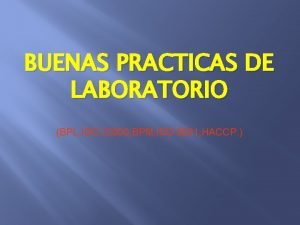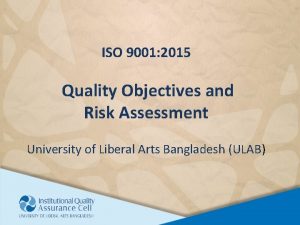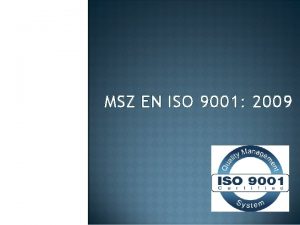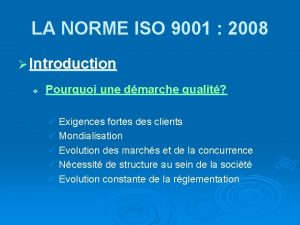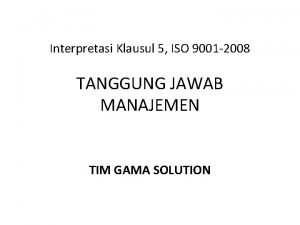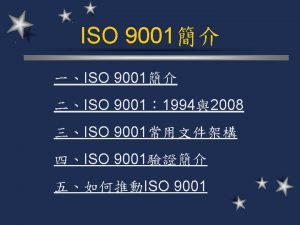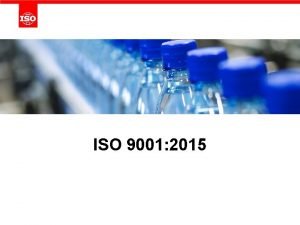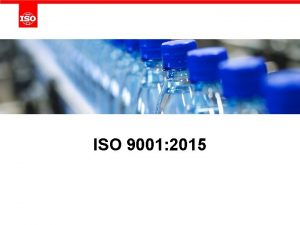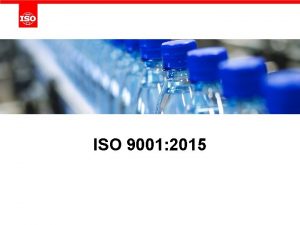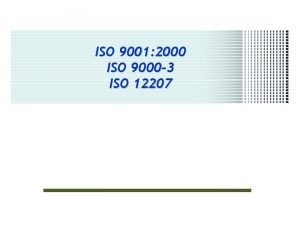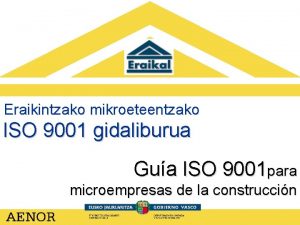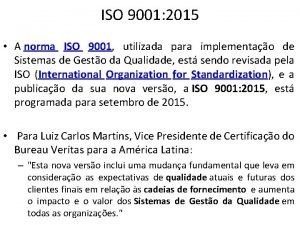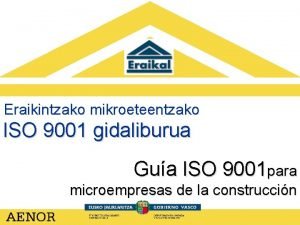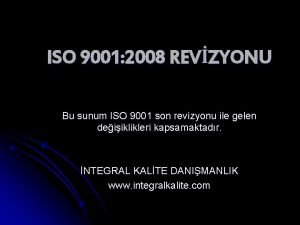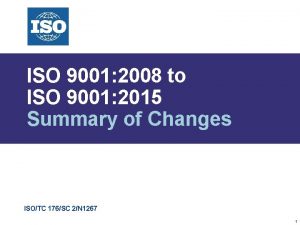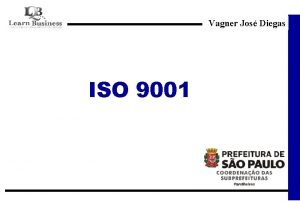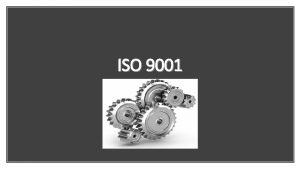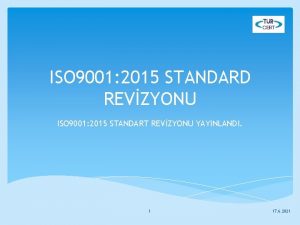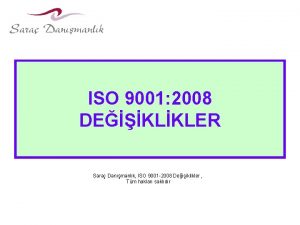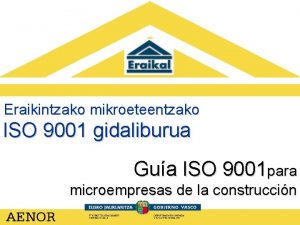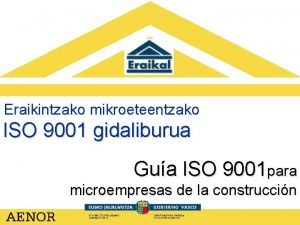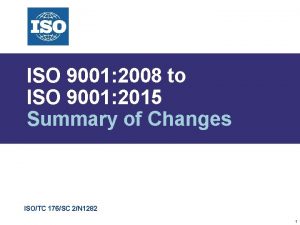ISO 9001 2000 ISO 9001 is the creation




















- Slides: 20

ISO 9001: 2000 • ISO 9001 is the creation of the International Organisation for Standardisation (ISO), a Swiss-based federation of national standards bodies. • ISO 9001 is part of the ISO 9000 family of standards. The new ISO 9001: 2000 designation comprises the ISO 9001, ISO 9002, and ISO 9003 standards. • ISO 9001 targets the manufacturing process, although it also includes manufacturing services and software development. • Contains 20 requirements that must be present for an effective QA system • ISO 9001: 2000 standard is applicable to all engineering disciplines, including SE • ISO guidelines 9000 -3 have been developed to interpret the standard for the use in the software processes • ISO started out as a European standard. 1

CMM • Capability Maturity Model: A reference model of mature practices in a specified discipline, used to assess a group’s capability to perform that discipline • “Capability Maturity Model®” and CMM® are used by the Software Engineering Institute (SEI) to denote a particular class of maturity models • CMMs differ by – Discipline (software, systems, acquisition, etc. ) – Structure (staged versus continuous) – How Maturity is Defined (process improvement path) – How Capability is Defined (institutionalization) 2

CMMI Representations • There are two types of representations in the CMMI models: –staged –continuous 3

CMMI Representations A representation allows an organization to pursue different improvement objectives • The organization and presentation of the data are different in each representation. However, the content is the same. 4

Staged Representation • Provides a proven sequence of improvements, each serving as a foundation for the next • Permits comparisons across and among organizations by the use of maturity levels • Provides an easy migration from the SW-CMM to CMMI • Provides a single rating that summarizes appraisal results and allows comparisons among organizations Indicates maturity of an organization’s standard process -- to answer, “What is a good order for approaching improvement across the organization? ” 5

Maturity Levels • A maturity level is a well-defined evolutionary plateau of process improvement. • There are five maturity levels. • Each level is a layer in the foundation for continuous process improvement using a proven sequence of improvements, beginning with basic management practices and progressing through a predefined and proven path of successive levels. 6

The Maturity Levels Optimizing 5 Focus on continuous process improvement Quantitatively Managed 4 Process measured and controlled 3 Process characterized for the organization and is proactive Defined Managed 2 Process characterized for projects and is often reactive 1 Process unpredictable, poorly controlled, and reactive Initial 7

Software Engineering II Lecture 44 Fakhar Lodhi 8

Recap 9

Continuous Representation • Allows you to select the order of improvement that best meets your organization’s business objectives and mitigates your organization’s areas of risk • Enables comparisons across and among organizations on a process-area-by-process-area basis Indicates improvement within a single process area -- to answer, “What is a good order for approaching improvement of this process area? ” 10

Capability Levels • There are six capability levels. • For capability levels 1 -5, there is an associated generic goal. • Each level is a layer in the foundation for continuous process improvement. • Thus, capability levels are cumulative, i. e. , a higher capability level includes the attributes of the lower levels. 11

The Capability Levels 5 Optimizing 4 Quantitatively Managed 3 Defined 2 Managed 1 Performed 0 Incomplete 12

Representing Capability Levels for a Single Process Area Capability Level • The process area capability of an implemented process can be represented by a bar. This point represents a higher level of “maturity” than this point in a specific process area 3 2 1 0 Process Area n Process 13

Comparison of Representations Staged Continuous • Process improvement is measured using maturity levels. n. Process • Maturity level is the degree of process improvement across a predefined set of process areas. n. Capability • Organizational maturity pertains to the “maturity” of a set of processes across an organization improvement is measured using capability levels. level is the achievement of process improvement within an individual process area. n. Process area capability pertains to the “maturity” of a particular process across an organization. 14

CMMI Model Representations 15

Level 5 Optimizing 4 Quantitatively Managed 3 Defined Focus Continuous process improvement Quantitative management Process standardization (SS) (IPPD) 2 Managed Basic project management Process Areas Organizational Innovation and Deployment Causal Analysis and Resolution Organizational Process Performance Quantitative Project Management Requirements Development Technical Solution Product Integration Verification Validation Organizational Process Focus Organizational Process Definition Organizational Training Integrated Project Management Integrated Supplier Management Risk Management Decision Analysis and Resolution Organizational Environment for Integration Integrated Teaming Requirements Management Project Planning Project Monitoring and Control Supplier Agreement Management Measurement and Analysis Process and Product Quality Assurance Configuration Management 1 Initial 16

Staged Representation: Process Areas by Maturity Level 17

Category Project Management Support Engineering Process Management Process Area Project Planning Project Monitoring and Control Supplier Agreement Management Integrated Project Management(IPPD) Integrated Supplier Management (SS) Integrated Teaming (IPPD) Risk Management Quantitative Project Management Configuration Management Process and Product Quality Assurance Measurement and Analysis Causal Analysis and Resolution Decision Analysis and Resolution Organizational Environment for Integration (IPPD) Requirements Management Requirements Development Technical Solution Product Integration Verification Validation Organizational Process Focus Organizational Process Definition Organizational Training Organizational Process Performance Organizational Innovation and Deployment 18

Continuous Representation: Organization of Process Areas 19

CMM vs ISO • The key difference between ISO 9001 and CMM is understanding that the software process is both a software process and a manufacturing process, ISO 9001 and the whole ISO process approaches software from a manufacturing standpoint. CMM approaches it from a development standpoint. ” • The CMM model was designed with five levels of maturity, ISO does not have them. • CMM standards are more stringent that ISO standards are very loose. • ISO does not say you have to have certain standards, but CMM says you must meet these standards • CMM was designed to ensure bug-free development. And ISO is designed to put quality into the manufacturing process. Their processes are different. Some versions of CMM and ISO have been merged 20 together.
 Norma iso 9000 2000
Norma iso 9000 2000 Iso 9001 2000 training
Iso 9001 2000 training Uni en iso 9001 2000
Uni en iso 9001 2000 Iso 9001 2000 auditor training
Iso 9001 2000 auditor training Iso 9001 krav
Iso 9001 krav Iso 9001 iso 14001 ohsas 18001 comparison
Iso 9001 iso 14001 ohsas 18001 comparison Efqm
Efqm Agile iso 9001
Agile iso 9001 änderungsmanagement iso 9001
änderungsmanagement iso 9001 Bvqi iso 9001
Bvqi iso 9001 Iso 90003
Iso 90003 Procesmodel iso 9001
Procesmodel iso 9001 Vorgabedokumente iso 9001
Vorgabedokumente iso 9001 Iso 9001:2008 certification in mumbai
Iso 9001:2008 certification in mumbai Bpm y bpl
Bpm y bpl Iso 9001:2015 risk assessment example
Iso 9001:2015 risk assessment example Iso 9001 2009
Iso 9001 2009 Norme iso 9001 2008
Norme iso 9001 2008 Iso 9001 prosedürleri
Iso 9001 prosedürleri Klausul 5 iso 9001
Klausul 5 iso 9001 Iso 9001:2015 awareness training ppt
Iso 9001:2015 awareness training ppt
